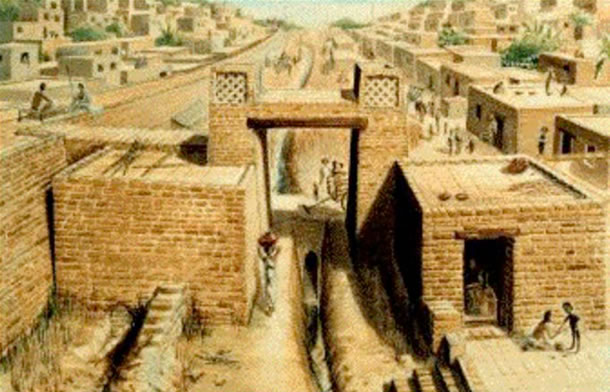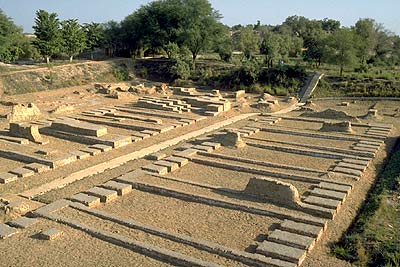Historical places of Pakistan: Harappa
Harappa is located in the Punjab Province of Pakistan and the site lies some 35 kilometres southwest of Sahiwal. Harappa is the first site of the Indus Valley Civilization that was discovered in the 1920s. Harappa is located about 250 kilometres from Lahore.

Harappa has been the centre of curiosity and interest among history students, historians and archaeologists since its discovery some 85 years ago. A date with history is what takes many tourists to Harappa. Excavations in Harappa have revealed a civilization, which was excellent in town planning and other sphere of every day life.
Harappa, the type-site of the Indus civilization, is today a large village in the Montgomery District of Punjab, 15 miles southwest of the district town. It overlies and adjoins the mounds of the ancient city, which appear to have had a circuit of not less than 3 miles, though the more emphatic mounds occupy a considerably smaller expanse.
The site at Harappa was first briefly excavated by Sir Alexander Cunningham in 1872-73; two decades after brick robbers carried off the visible remains of the city. He found an Indus seal of unknown origin. The first extensive excavations at Harappa were started by Rai Bahadur Daya Ram Sahni in 1920. His work and contemporaneous excavations at Mohenjo-daro first brought to the world's attention the existence of the forgotten Indus Valley civilization as the earliest urban culture in the Indian subcontinent.

His work was followed later in the decade by that of Madho Sarup Vats, also of the Archaeological Survey of India. Excavations by other archaeologists continued in the 1930's, and in1946 Sir Mortimer Wheeler excavated the so-called fortification walls and found the first pre-Indus Valley civilization (Kot Dijian) deposits. After independence, Harappa was excavated by Mohammed Rafique Mughal of the Archaeological Survey of Pakistan in 1966. In 1986, the first systematic, multi-disciplinary excavations of an Indus Valley city were begun by the Harappa Archaeological Project (HARP), under the direction of George F. Dales and J. Mark Kenoyer.
The main features of the plan, the citadel on the west and the mounds of the ‘lower city’ towards the east and southeast have already been indicated. To the north a slightly hollowed belt containing notably green crops marks an old bed of the River Ravi. Today the river flows 6 miles further north. Between the citadel and the riverbed, Mound F has been found to contain a remarkable and significant piece of town planning; to the south of the citadel lie the outlying hills, the Harappan cemetery and the post Harappan cemetery. To the southeast, sporadic digging has been carried out in Area G, but the ragged Mound E and its surroundings are virtually unexplored.
There is an enormous amount still to be learned about the site, most of which remains unexcavated. The earliest deposits on the site go back to 5300 B.P. and the area seems to have been continuously inhabited ever since. Archaeologists think that ancient Harappa was the urban center dominating the upper Indus region, much like Mohenjo-daro dominated the lower Indus Valley and Ganweriwala might have been the urban center for what is now Rajasthan.
Archaeological evidence is the key to understanding Harappa’s past. Although Harappa continues to be the center of historical debate, further archaeological explanations may some day reveal the validity or inaccuracy in the historical accounts of Harappa. Regardless of its impact on written history, archaeology will continue to reveal the way of life for Harappa's inhabitants
It is the excellent town planning that have received kudos from the historians and archaeologists. The houses at Harappa were built in burned brick and had excellent drainage system. Every house had a well as an integral part of it. Roads were wide and were well connected to the streets. Excavations have unearthed a number of artefacts that provide a glimpse of the way of life and various customs and traditions prevalent in Harappa. The cemeteries found in Harappa gives a clear indication that the Harappan people used to burry their dead. They were fond of wearing necklace, ring, bangle and other jewellery. As, many skeletons found in Harappa had beads and anklets in their grave.
Harappa is located in the Punjab Province of Pakistan and the site lies some 35 kilometres southwest of Sahiwal. Harappa is the first site of the Indus Valley Civilization that was discovered in the 1920s. Harappa is located about 250 kilometres from Lahore.

Harappa has been the centre of curiosity and interest among history students, historians and archaeologists since its discovery some 85 years ago. A date with history is what takes many tourists to Harappa. Excavations in Harappa have revealed a civilization, which was excellent in town planning and other sphere of every day life.
Harappa, the type-site of the Indus civilization, is today a large village in the Montgomery District of Punjab, 15 miles southwest of the district town. It overlies and adjoins the mounds of the ancient city, which appear to have had a circuit of not less than 3 miles, though the more emphatic mounds occupy a considerably smaller expanse.
The site at Harappa was first briefly excavated by Sir Alexander Cunningham in 1872-73; two decades after brick robbers carried off the visible remains of the city. He found an Indus seal of unknown origin. The first extensive excavations at Harappa were started by Rai Bahadur Daya Ram Sahni in 1920. His work and contemporaneous excavations at Mohenjo-daro first brought to the world's attention the existence of the forgotten Indus Valley civilization as the earliest urban culture in the Indian subcontinent.

His work was followed later in the decade by that of Madho Sarup Vats, also of the Archaeological Survey of India. Excavations by other archaeologists continued in the 1930's, and in1946 Sir Mortimer Wheeler excavated the so-called fortification walls and found the first pre-Indus Valley civilization (Kot Dijian) deposits. After independence, Harappa was excavated by Mohammed Rafique Mughal of the Archaeological Survey of Pakistan in 1966. In 1986, the first systematic, multi-disciplinary excavations of an Indus Valley city were begun by the Harappa Archaeological Project (HARP), under the direction of George F. Dales and J. Mark Kenoyer.
The main features of the plan, the citadel on the west and the mounds of the ‘lower city’ towards the east and southeast have already been indicated. To the north a slightly hollowed belt containing notably green crops marks an old bed of the River Ravi. Today the river flows 6 miles further north. Between the citadel and the riverbed, Mound F has been found to contain a remarkable and significant piece of town planning; to the south of the citadel lie the outlying hills, the Harappan cemetery and the post Harappan cemetery. To the southeast, sporadic digging has been carried out in Area G, but the ragged Mound E and its surroundings are virtually unexplored.
There is an enormous amount still to be learned about the site, most of which remains unexcavated. The earliest deposits on the site go back to 5300 B.P. and the area seems to have been continuously inhabited ever since. Archaeologists think that ancient Harappa was the urban center dominating the upper Indus region, much like Mohenjo-daro dominated the lower Indus Valley and Ganweriwala might have been the urban center for what is now Rajasthan.
Archaeological evidence is the key to understanding Harappa’s past. Although Harappa continues to be the center of historical debate, further archaeological explanations may some day reveal the validity or inaccuracy in the historical accounts of Harappa. Regardless of its impact on written history, archaeology will continue to reveal the way of life for Harappa's inhabitants
It is the excellent town planning that have received kudos from the historians and archaeologists. The houses at Harappa were built in burned brick and had excellent drainage system. Every house had a well as an integral part of it. Roads were wide and were well connected to the streets. Excavations have unearthed a number of artefacts that provide a glimpse of the way of life and various customs and traditions prevalent in Harappa. The cemeteries found in Harappa gives a clear indication that the Harappan people used to burry their dead. They were fond of wearing necklace, ring, bangle and other jewellery. As, many skeletons found in Harappa had beads and anklets in their grave.
No comments:
Post a Comment